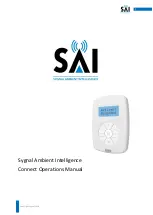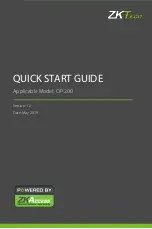
18. Never operate the hoist when flammable materials or
vapors are present. Sharp contact between metal parts can
produce sparks that can cause a fire or explosion.
19. Do not use the hoist when you are tired, distracted or under
the influence of drugs, alcohol or medication, causing
reduced control.
Place warning signs and barriers in area when overhead
maintenance is taking place.
MAINTENANCE OF LEVER HOIST AFTER USE
1. After use, set the directional lever to the “UNLOAD” position
and move the lever up and down to disengage the brake.
2. Remove any dirt or dust from the hoist and chain.
3. Lubricate load chain with a light coating of Bar and Chain Oil
such as Lubriplate 10-R
®
(Fiske Bros. Refining Co.) or equal
lubricant.
4. Store the lever hoist in a dry, clean area.
INSPECTION
To maintain continuous and satisfactory operation, a regular
inspection procedure must be initiated so that worn or damaged
parts can be replaced before they become unsafe. The intervals
of inspection must be determined by the individual application
and must be based upon the type of service to which the hoist
will be subjected. Conduct inspections only when there is no
load on hoist. Place warning signs and barriers in area when
overhead maintenance is taking place.
The inspection of hoists is divided into two general
classifications designated as “frequent” and “periodic”. Frequent
inspections are performed daily. Periodic inspections are
performed every three (3) months (unless otherwise specified).
Periodic inspections will require partial disassembly of the hoist
(See “Three Point of Caution for Hoist Disassembly” and
“Assembly”).
THREE POINTS OF CAUTION FOR HOIST DISASSEMBLY
Three points of caution are to be observed when
disassembling this tool.
1. Loose rollers are used for the liftwheel bearing on the 3/4
ton (750 Kg), 1½ ton (1 500 Kg) and 3 ton (3 000 Kg) units.
Do not lose these rollers as they may drop from the unit as
various parts are disassembled.
2. The latch is secured to the upper and lower hook by a rivet.
To remove the latch, it is necessary to remove the head of
the rivet by grinding or drilling. For replacement of the latch
refer to assembly instructions.
3. The pinion shaft and ratchet hub pawl and shaft are under
spring pressure and may fly out of the unit upon
disassembly.
FREQUENT INSPECTIONS
These inspections are usually visual examinations by the
operator or other designated personnel. The frequent
inspections are to be performed daily or before each use and
should include the following items:
1. All functional operating mechanisms for maladjustment and
unusual sounds.
2. Hoist braking mechanisms for evidence of slippage.
3. Operation of the directional lever for free movement.
4. Load chain for lubricant, wear, damaged links or foreign
material.
5. Proper reeving of load chain (See “Reeving Load Chain”
under “Maintenance” section).
6. Hooks for damage, cracks, twists, latch engagement and
latch operation.
7. Hoist support for damage.
Any deficiencies noted are to be corrected before the hoist is
returned to service.
PERIODIC INSPECTIONS
These are visual inspections by an appointed and qualified
person or service center who makes records of apparent
external conditions to provide the basis for a continuing
evaluation. The periodic inspections are to be performed every
three (3) months unless otherwise specified in this manual.
Due to the construction of the hoist, it will be necessary to
partially disassemble the unit to perform the periodic
inspections (See “Three Points of Caution for Hoist
Disassembly” and “Assembly”).
The periodic inspections are to include those items listed under
frequent inspections as well as the following:
1. Inspect chain and end connections for excessive wear or
stretch.
2. Check for worn, cracked or distorted parts such as lower
hook block, upper hook block, upper hook pin, chain guide
roller, stripper, side plates, gear cover, gears, bushings,
lever, brake cover, free chaining knob, ratchet hub pawl,
cam guide, friction hub and lever ratchet hub.
3. Inspect for wear on the pawl tips, teeth of the ratchet and
pockets of the liftwheel.
4. Check for loose or missing bolts, nuts, pins or rivets.
5. Inspect brake components for worn, glazed or
contaminated friction discs, and scoring of friction hub and
ratchet. Replace friction washers if contaminated, glazed or
if thickness is less than 0.094 in. (2.4 mm).
6. Check for corroded, stretched or broken pawl springs,
ratchet hub pawl spring and pinion spring.
7. Check for free movement of the pawls on the pawl studs.
Apply a thin coat of lubricant to the pawl studs before
reassembling the unit (See “Lubrication” under
“Maintenance” section).
6
To reduce the risk of injury, operate hoist using
manual power only. Power operation may result in
structural damage or premature wear that may cause
a part to break and allow the load to fall.
To reduce the risk of injury, do not allow the load to
bear against the hook latch and/or hook tip. Apply
load to hook bowl or saddle only. Allowing the load to
bear against the hook latch and/or hook tip can
result in loss of load.
MAINTENANCE



































